The ultimate guide to aligning your lifecycle emails and in-app messaging

.png)

.png)
Previously on the Appcues Blog, Sarah Knapp dug deep into the idea of creating an omnichannel onboarding experience for your new users.
There, Knapp discussed the importance of creating a truly interconnected omnichannel onboarding experience—with a specific focus on merging in-app and email communications in a variety of ways.
To be sure, these 2 channels certainly can be used in conjunction with one another to enhance your onboarding experience—but there’s no need to stop there. Instead, we suggest that you use this double-barreled approach to communication throughout the customer lifecycle.
Which is exactly what we’re going to be talking about today.
Customer lifecycle marketing refers to the process of engaging with specific customers for a specific purpose, based on where, specifically, these customers are in their user journey with your brand.
Basically, the idea is to provide exactly what the customer needs to continue their journey in the right direction.
A few examples:
Adopting an omnichannel approach to lifecycle marketing can be beneficial to both your customers and your business.
For one thing, engaging with your users on multiple channels increases the amount of exposure they have to your brand. Tangibly, this increases the chances that your users will see your message in the first place (since they’ll likely see it more than once on different channels). In the more abstract sense, increased exposure to your brand will likely lead to increased brand recall—in turn leading to more habitual use of your product or service.
Moreover, this omnichannel approach can enhance the quality of your customers’ experiences with your brand. Instead of creating separate communications for different channels, you’ll use each channel to strengthen singular messages at various times throughout the customer journey. This will lead your customers to continue digging deeper into the experience you’ve created for them.
Which brings us back to the main purpose of customer lifecycle marketing: increasing user engagement, and getting your users to take the “next step” in their journey. Again, it’s all about giving the customer exactly what they need—be it further instruction, timely prompts and reminders, or additional offers of value—to keep them engaged as active users of your product or service.
If you can consistently deliver all this to your customers at every point along their journey, you’ll have little trouble growing a raving crowd of loyal users.
Now, let’s dig into the many ways you can align and integrate your lifecycle emails with your in-app messages. More specifically, we'll look at:
Let's get to it.
User onboarding is probably the most critical stage of the entire customer lifecycle, because it sets new users up for success (or failure) down the line.
At this point, your new users may have a pretty good idea of the value your app has to offer in the abstract… but they likely don’t know how to use your app to fully extract this value.
It’s your job, then, to quickly get them up to speed—and to keep them motivated and engaged as they navigate your app and your overall brand experience.
By tying your in-app messaging to your email communications throughout the onboarding stage, you’ll reinforce not just the information and prompts being provided, but also the relationship you’ve begun to forge with your new users.
Here’s how to make it happen.
The very first part of the user onboarding experience involves welcoming newcomers to your app and brand.
To initiate this stage in the first place, the new user will need to officially register for your services.
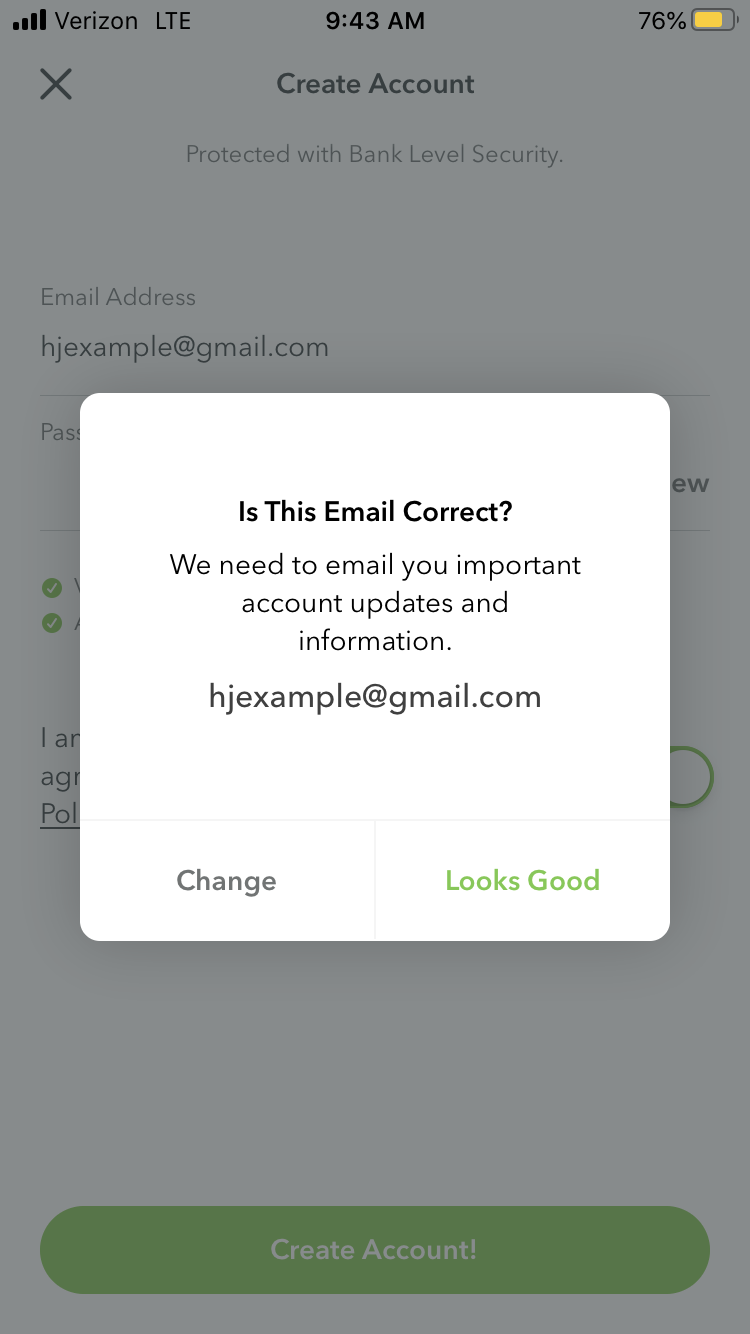
(Note: As we’ve discussed before, you may want to allow new users to experiment with your app a bit before requiring them to sign up. For the purpose of this conversation, we’ll assume the user is 100% prepared to register.)
Once new users provide their contact information, you can set a confirmation email to be sent automatically to their inbox.

With regard to double opt-in prompts, there’s no single “best” approach. Rather, it depends on what works best to engage your target audience.
(The screenshot from Acorns, for example, has new mailing list members confirm via email that they did, in fact, intend to sign up for the service within the app. You could also have those who sign up for your service via your website confirm their registration via in-app messaging or email—depending on which is most effective for your audience.)
A double opt-in prompt all but ensures those who confirm their registration are prepared to move forward with their experience.
You might also use your confirmation email as a means of reinforcing the value of your app, as Ibotta does here:

Once you’ve confirmed your new user’s contact info, your next step will be to extract additional information about their profile and their needs—while also introducing them to your app’s features.
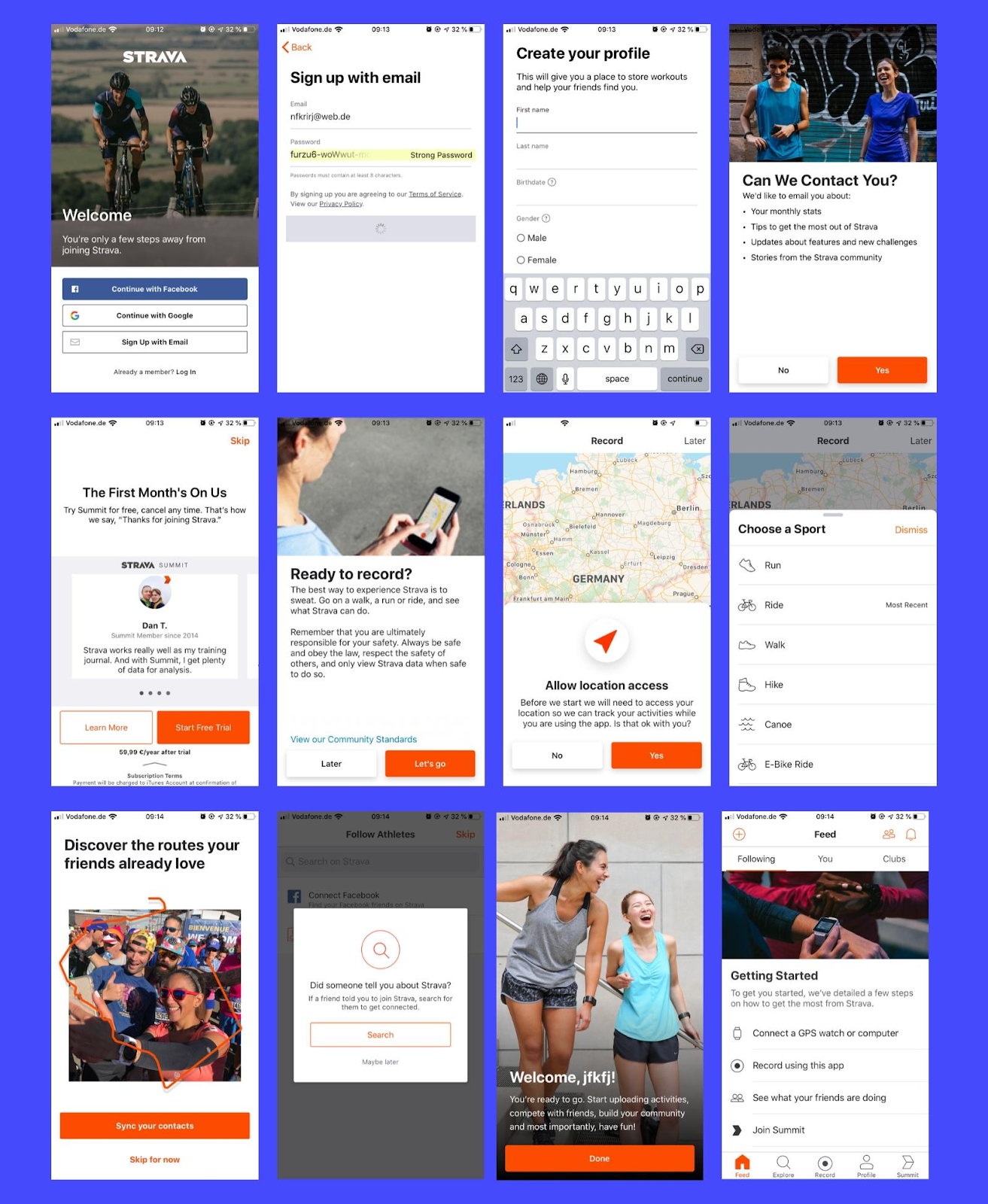
Throughout this onboarding workflow, Strava:
Strava backs up these in-app messages with a welcome email that summarizes the app’s functionality and prompts the user to take further action:
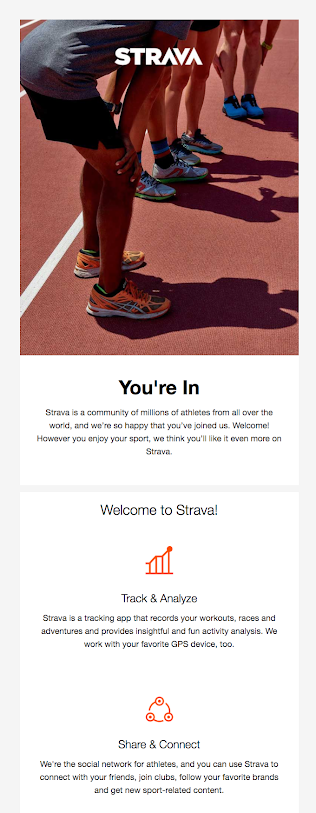
MailChimp takes a similar approach to this introductory phase, by asking new users to answer a series of questions that help MailChimp tailor the experience to each user’s needs:

These questions allow MailChimp to further segment individual users from the get-go—and begin delivering highly relevant and valuable content to their email inbox right away.
The goal here is to ensure your new users know exactly what they’re getting into when signing up for your app, and to learn as much as you can about their unique needs in order to provide maximum value to them at all times.
From there, you’ll be ready to ramp up their onboarding experience by...
Once a new user has completed the initial intake process, they’ll be ready to learn how to use your app.
At this stage, you’ll want to use email as a means of communicating “big picture” messaging, and your in-app messaging for more “nitty-gritty” prompts and instructions.
For example, Square sends new users an email that allows them to complete a multitude of tasks at their own pace, in whichever order they choose:

The risk is that users won’t revisit this type of onboarding email and complete all the calls-to-action within. Another approach, is to break up these early learning tasks and create onboarding email drips to be delivered on a regular basis as the user gets acclimated with your app.
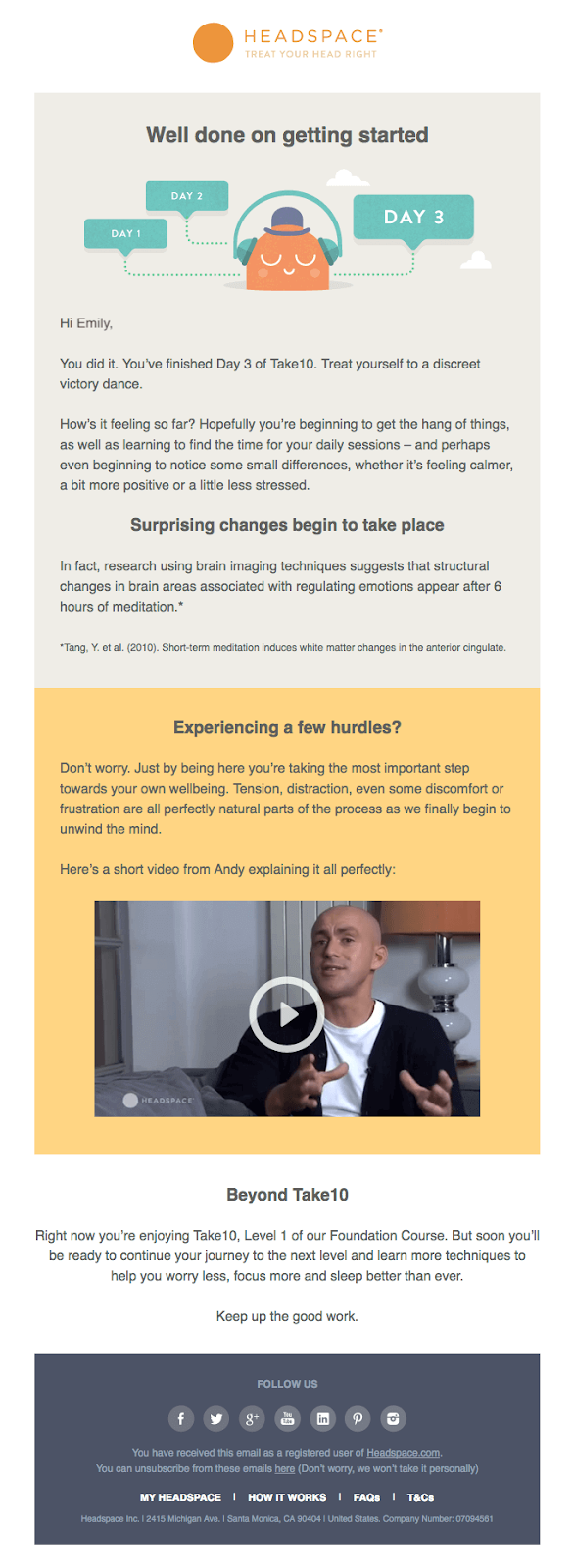
In the example above, Headspace accomplishes a few things really well:
First, the email acknowledges the user’s progress, and points out some of the hidden growth that is taking place within them. Second, it addresses any objections or fears the user may have regarding their experience thus far—and explains how to overcome them. Finally, it provides a gentle reminder to “keep up the good work”—prompting the user to return to the app as intended.
All of this is then reinforced directly within the app, via in-app messaging and gamified elements throughout the app experience:
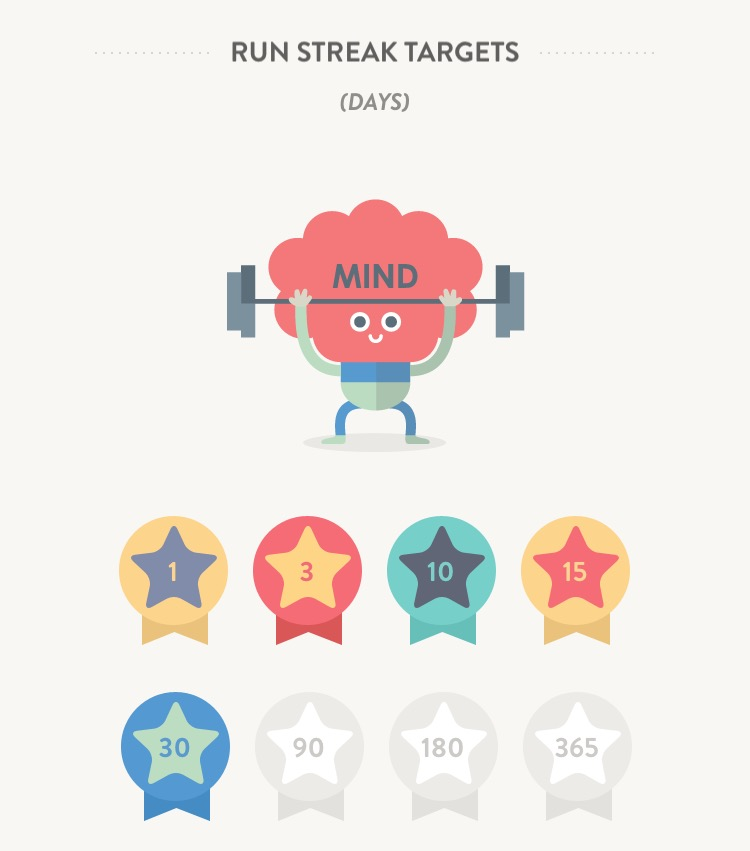
Now, there may be times where your new users fail to take certain actions that would enhance their overall experience, either by adding delight or making them more successful users. In this case, you’ll want to send a targeted email reminding these users to take action—and explaining what they stand to gain by doing so.

In this example, downloading the desktop app will not only enhance the user’s overall experience with additional features, but will also provide Loom with another means of communicating with the user (via desktop notifications and further in-app messaging).
Whether you’re asking users to upgrade, download a different version of your app, or adopt new features, it should always be a win-win for you and your user.
Again, the onboarding process is all about getting new users up to speed and engaged with your app as quickly as possible. Because they may not yet use your app habitually—and therefore might not even see your in-app messages in the first place—it’s a good idea to use email as a springboard for further engagement, then back up these prompts with clear instruction within your app.
As we alluded to above, celebrating your new user’s progress is paramount to keeping them motivated to continue using your app on a regular basis.
Celebrating user progress helps improve both the user experience and your engagement rates by::
Once again, you’ll want to use email to celebrate “big picture” milestones, and in-app messaging for acknowledging quick wins and steady progress.
(The reason for this is simple: You want to celebrate quick wins directly and at the very moment your user makes progress—and you want to keep them on track in progressing even further. Pulling them away to their inbox after every quick win would only serve to distract them.)
Take the following example from Etsy:

Notice the uplifting nature of even the most basic copy. Here, the user simply selected USD as their preferred currency, and they’re met with an excited greeting, coupled with vital information for their account.
The point being:You don’t need to go overboard when celebrating quick wins. In many cases, you simply need to provide a quick pat on the back to let the user know they’re on the right track.
Now, in some cases, you’ll want to reinforce your acknowledgement of your user’s progress via email.
Using the example from above, Etsy might decide to send follow-up emails at certain points along the onboarding journey:
(Note that you wouldn’t force the user to engage with these emails before moving onto the next step—but this communication can still add value to the overall experience as an optional way to engage new users.)
The goal is to keep your new users moving forward in their onboarding journeyKeep them motivated and engaged, and they’ll be ready to use your services in no time.
Once a user is onboarded, the last thing you want to do is go completely incommunicado on them.
Reason being: There’s no guarantee they’ll continue using your app. Period.
Instead of leaving their return completely up to chance, your best option is to actively reach out to them in order to keep them engaged.
First and foremost, your goal is to get your newly onboarded users to begin using your app habitually, or as a matter of course.
This is where well-timed email reminders and push notifications come in.
How often you send these reminders should be related to how frequently your app is intended to be used, and/or the circumstances in which it’s meant to be used.
For example, Duolingo sends out push notifications and email messages at the same time every 24 hours (to users who have opted in to daily reminders, of course):
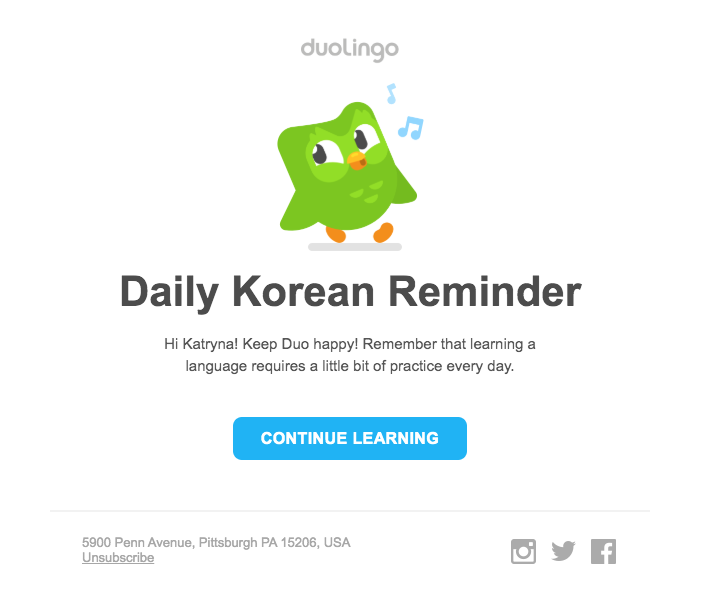

Note that each message uses different methods of nudging the user:
Both channels give users a clear reason to engage further with the app. And, if they happen to see both messages, well...they’ll have even more reasons to do so!
Again, the timing of your reminders depends on how, when, and why your users use your app.
You might choose to personalize these reminders based on individual use cases. For example, a workout app might send different reminders to a user on arms, legs, and chest day respectively. In backing up these reminders, the team might send emails reminding them of their progress, or of any “streaks” they might be breaking by missing a day.
For those whose usage rates start to decline, you’ll want to do whatever you can to get them back on track.
Duolingo takes both a proactive and reactive approach to re-engaging users. On a weekly basis, Duo sends users a progress report—complete with a comparison to their previous weeks’ work:
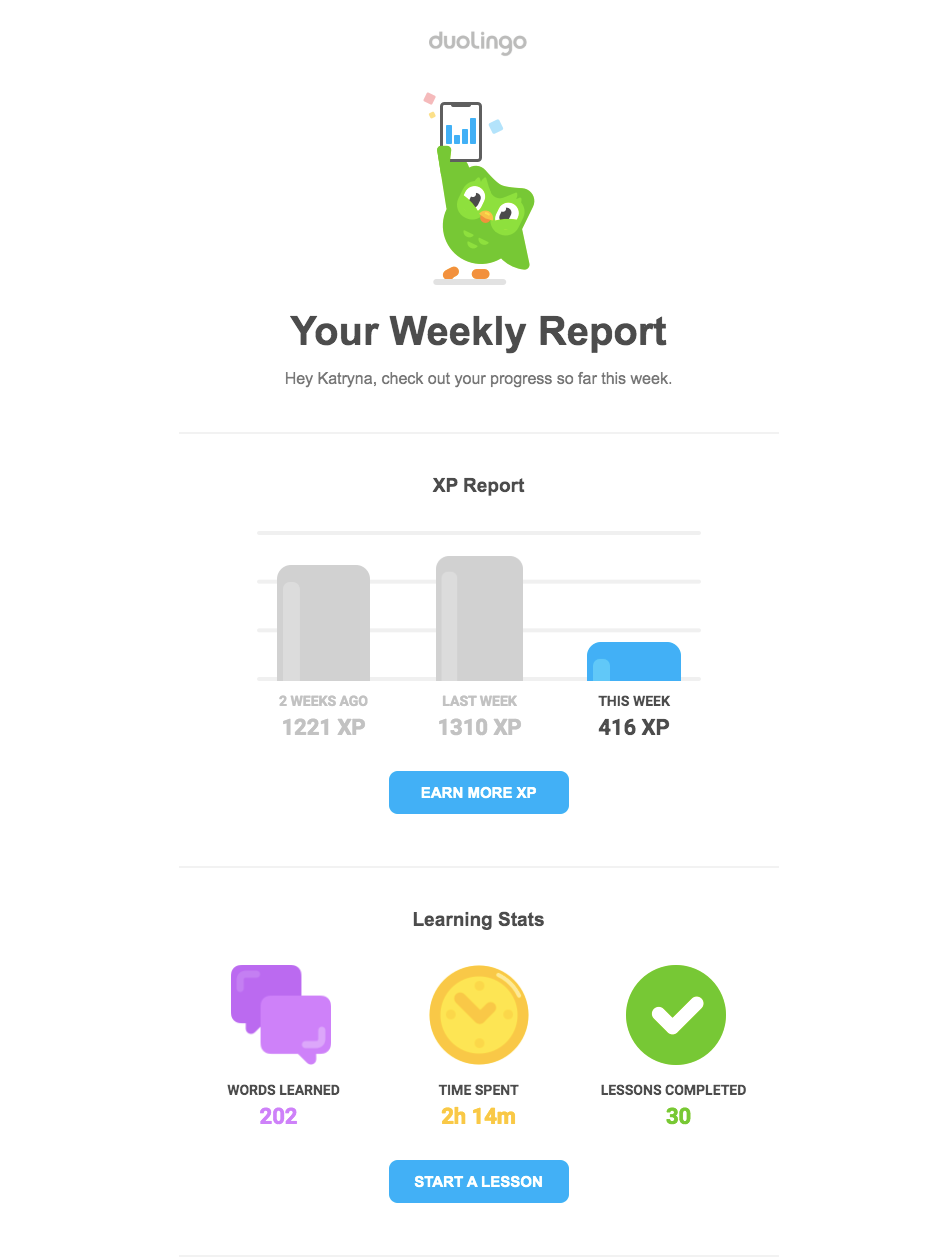
Here, users that haven’t been as active more recently might be inspired to get back into the habit upon seeing the progress they’d previously made.
On the reactive side, Duo sends individual emails to its at-risk users, and makes one last-ditch effort to engage via push notification:

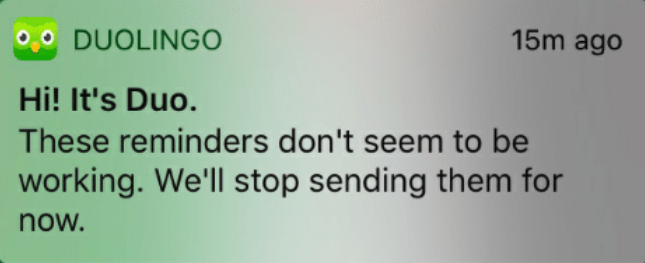
While it might be wise to include a bit more personalization in these winback messages, they both serve as a sort of low-pressure reminder to check back in on the app whenever possible.
It takes time for your users to develop habitual use of your services. That said, it’s essential that you deliver well-placed and well-timed reminders to your new users in order to integrate your app into their lives.
Beyond getting your users to habitually use your app’s basic functions, you also want to get them to dig deeper into all you have to offer as time goes on.
In some cases, you’ll be prompting the user to revisit certain tasks they may have skipped or glanced over during onboarding.
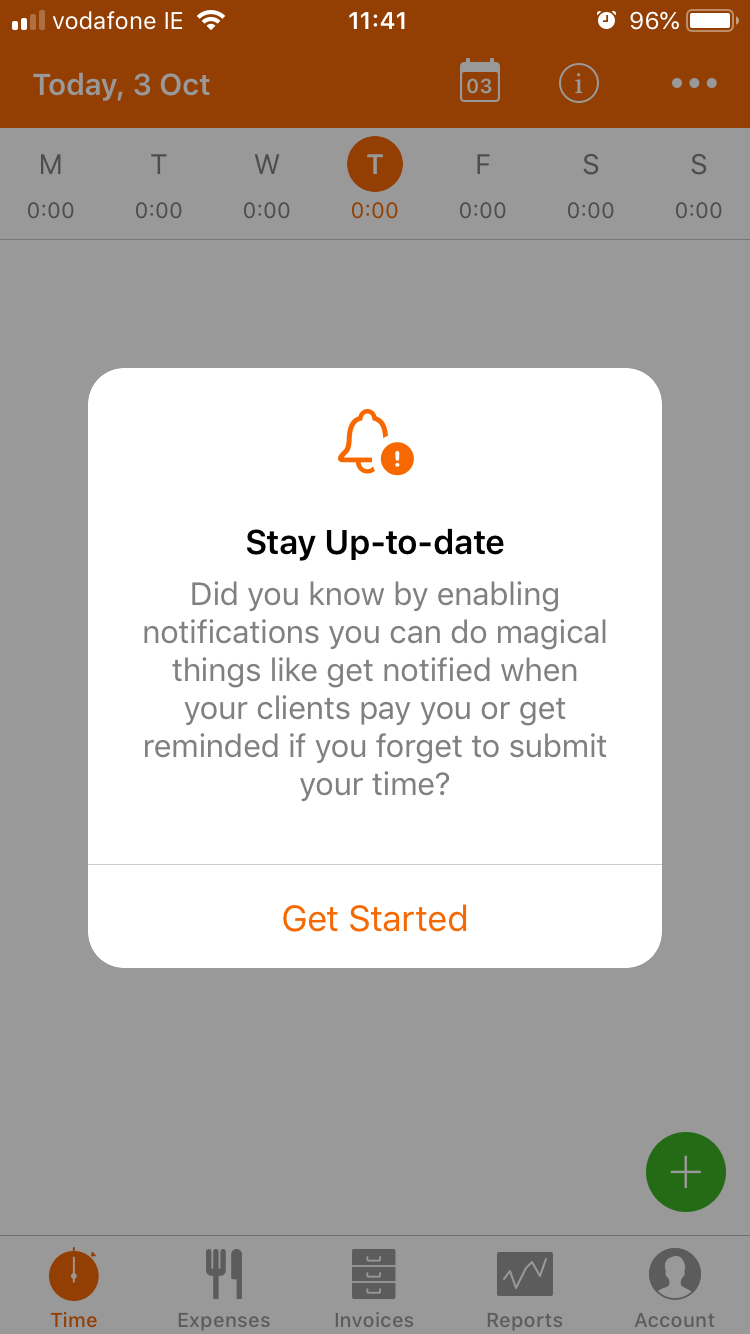
In this example, Harvest nudges users to turn on push notifications by focusing on what they stand to gain by doing so. Presumably, these push notifications will supplement the reminders Harvest sends via email at the appropriate times.
You can also be a bit more open-ended here, providing optional opportunities for your users to check out additional features and functionalities.
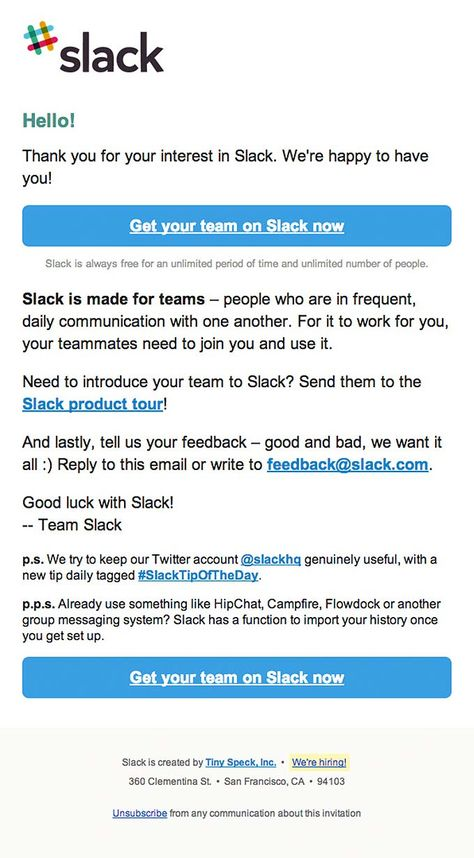
Slack presents a similar list of features and tips directly in the app, as well:
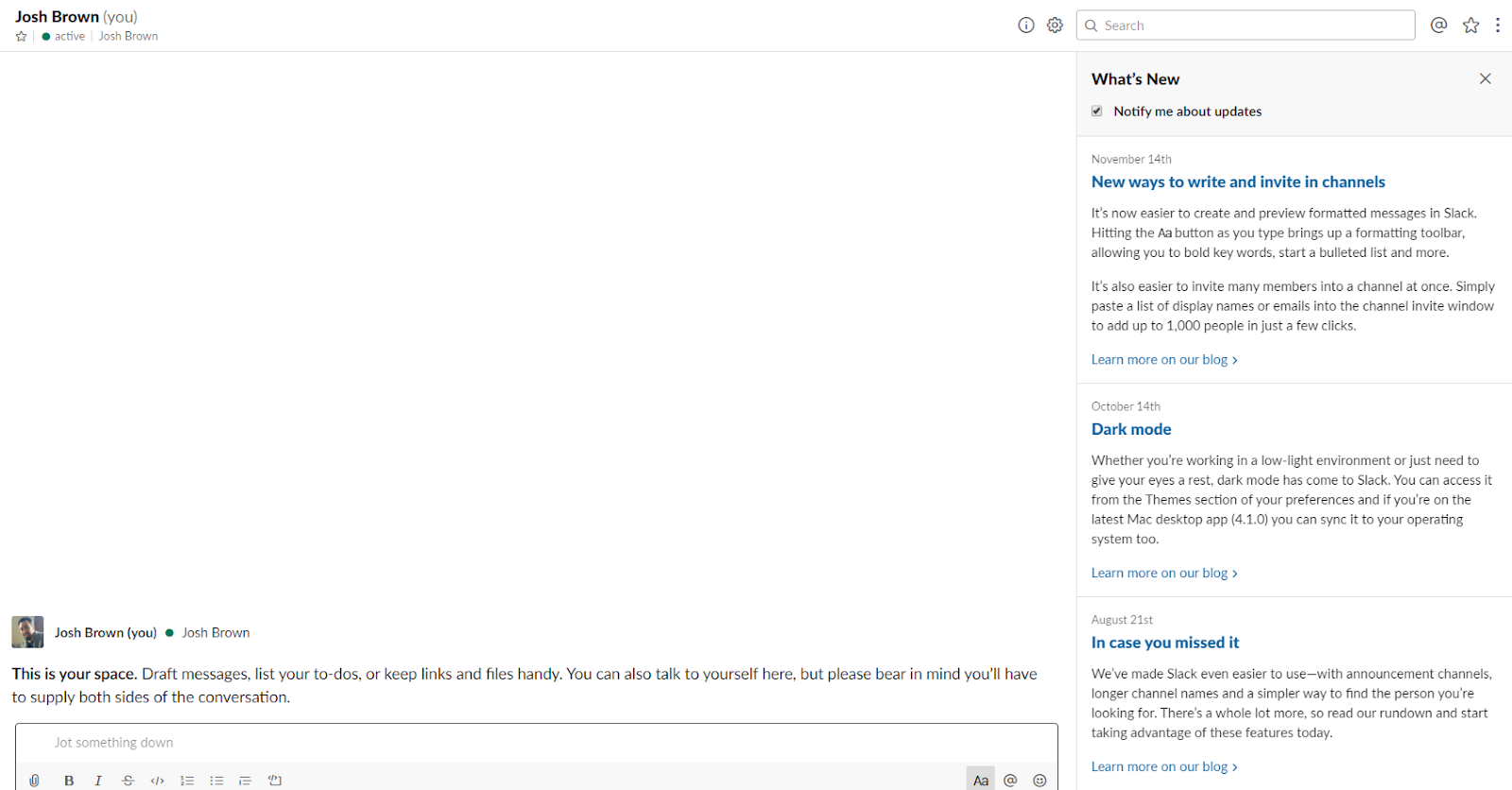
Note that in both cases, the initial message is used to point the user toward further resources on Slack’s blog or website. When you promote a specific resource or piece of content, it’s essential that your in-app and email messages are 100% in-line with one another.
(Otherwise, you run the risk of throwing way too much information at your users at a single time. In turn, they may be even less likely to engage further at all.)
As your users become familiar with your app, they’ll also become used to it—meaning the novelty of your app will eventually wear off. Unfortunately, this can lead to decreased engagement, and even churn.
To keep this from happening, you should always be introducing your users to new features, functionalities, and shortcuts that will benefit their individual experience with your app. And of course, you should support these introductions with additional content across a variety of channels.
Once your users have become regulars within your app, you’ll want to get an understanding of how their experience has been thus far.
To do so, you might decide to send out a quick 1 or 2-question survey directly within your app:

Note that Zomato allows users to provide feedback directly in the in-app form, but also gives them the option of emailing the team, as well.
Having options benefits the user, as it allows them to use their preferred channel to engage further with the brand while completing the survey. For the team, it increases the chances that users will give feedback in the first place—and also opens the door for them to provide more valuable, in-depth feedback, too.
You might also use your in-app survey to request further engagement via email:
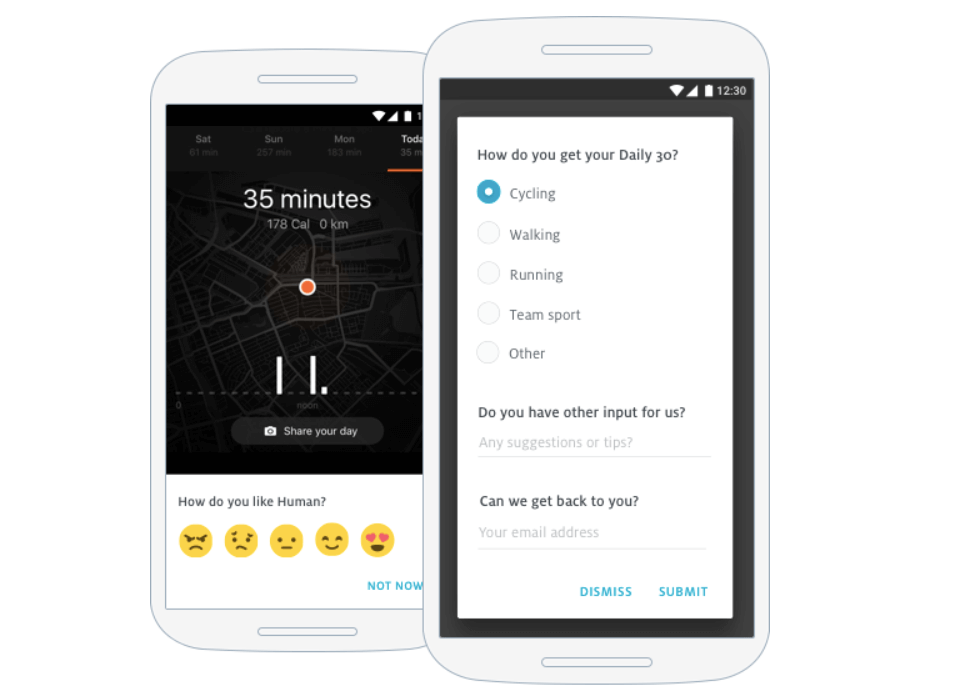
Here, Human asks a quick question about the user’s preferences via their app, then promises follow-up communications via email—preparing the user for further messages from the brand in the near future.
It’s also worth mentioning that not every customer in need of assistance will actively seek out help from your team. So, it’s up to you to proactively provide customer service throughout the customer lifecycle.

And, of course, if a customer does request assistance, you’ll want to follow up with them once their issue has been resolved:
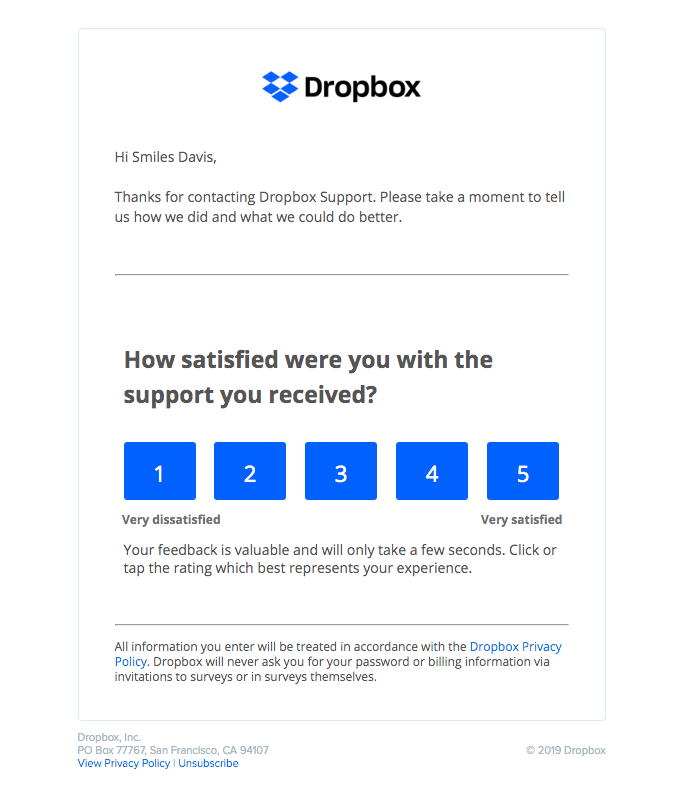
At this stage of the customer lifecycle, the aim is to get your users comfortable enough with your app that they begin to use it on a regular basis.
But “regular” use isn’t the end game.
The ultimate goal is to get your users to the point where they’re getting the most possible value from your app for their specific needs.
Incidentally, this also means that the user will be as engaged with your app as they possibly can be—meaning you’re getting maximum value from them, too.
There are a number of tricks to get (and keep) your users in a state of hyper-engagement. Such as...
As mentioned, you want to be absolutely sure your most-engaged users know how to get optimum use out of your app. Ultimately, you want to get these users to a place where they’re so advanced and capable, that they start to discover the edges of your app’s capabilities.
So, as your users become better versed in the ins and outs of your app, you’ll want to continue introducing even more advanced features, functions, and use cases to them.
In some cases, you’ll want to begin directly in the app, as MailChimp does here, with pro tips sprinkled throughout the user dashboard:
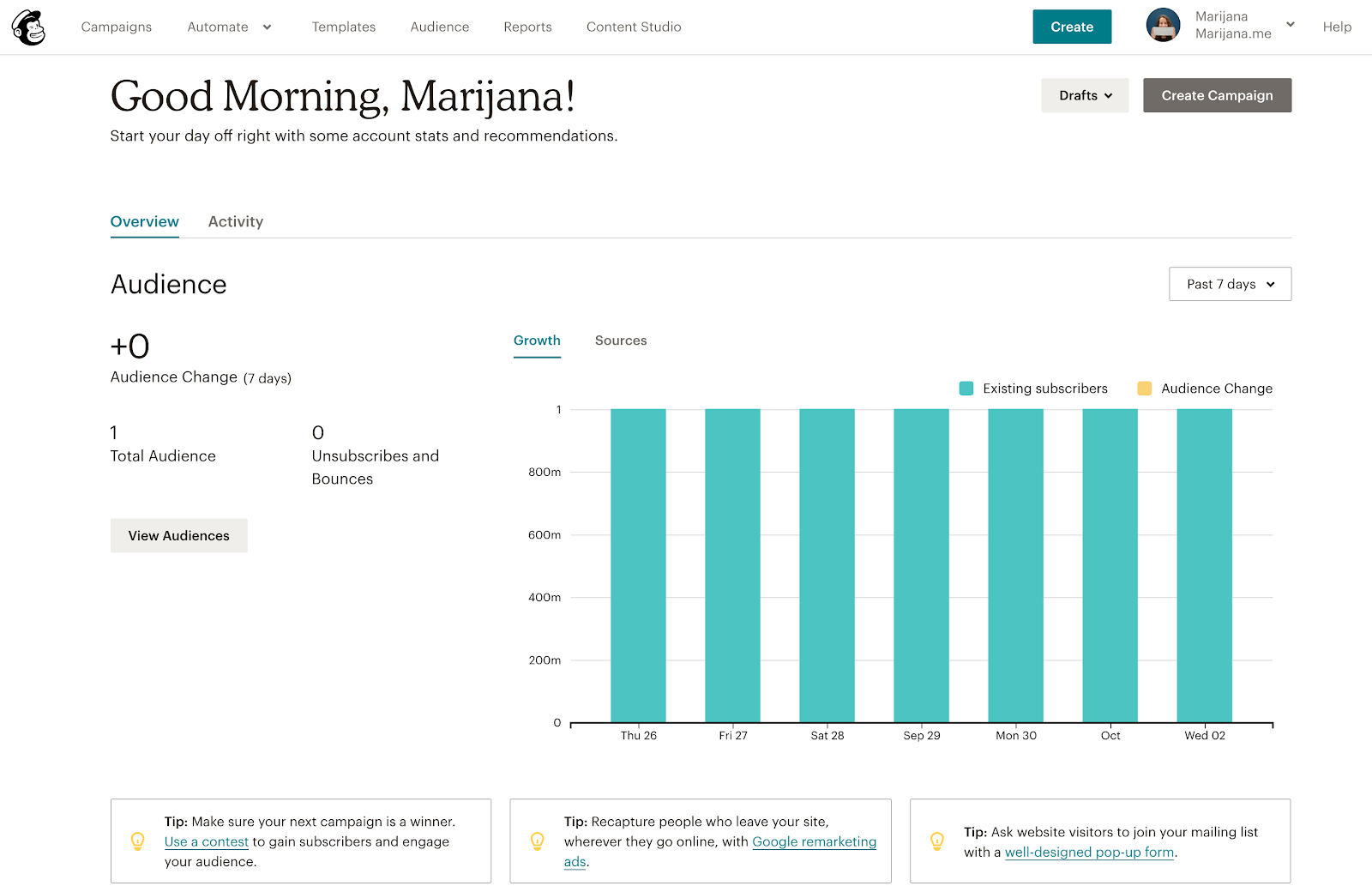
In a case such as the above, users who engage further with the tips could then be sent follow-up emails that dig deeper into the feature at hand. This would not only reinforce the lesson in question, but will also provide the user with documentation for future reference.
Of course, you can also use email to point out specific features and provide expert tips, as well, and follow up with contextual in-app messaging once users click through to your product:
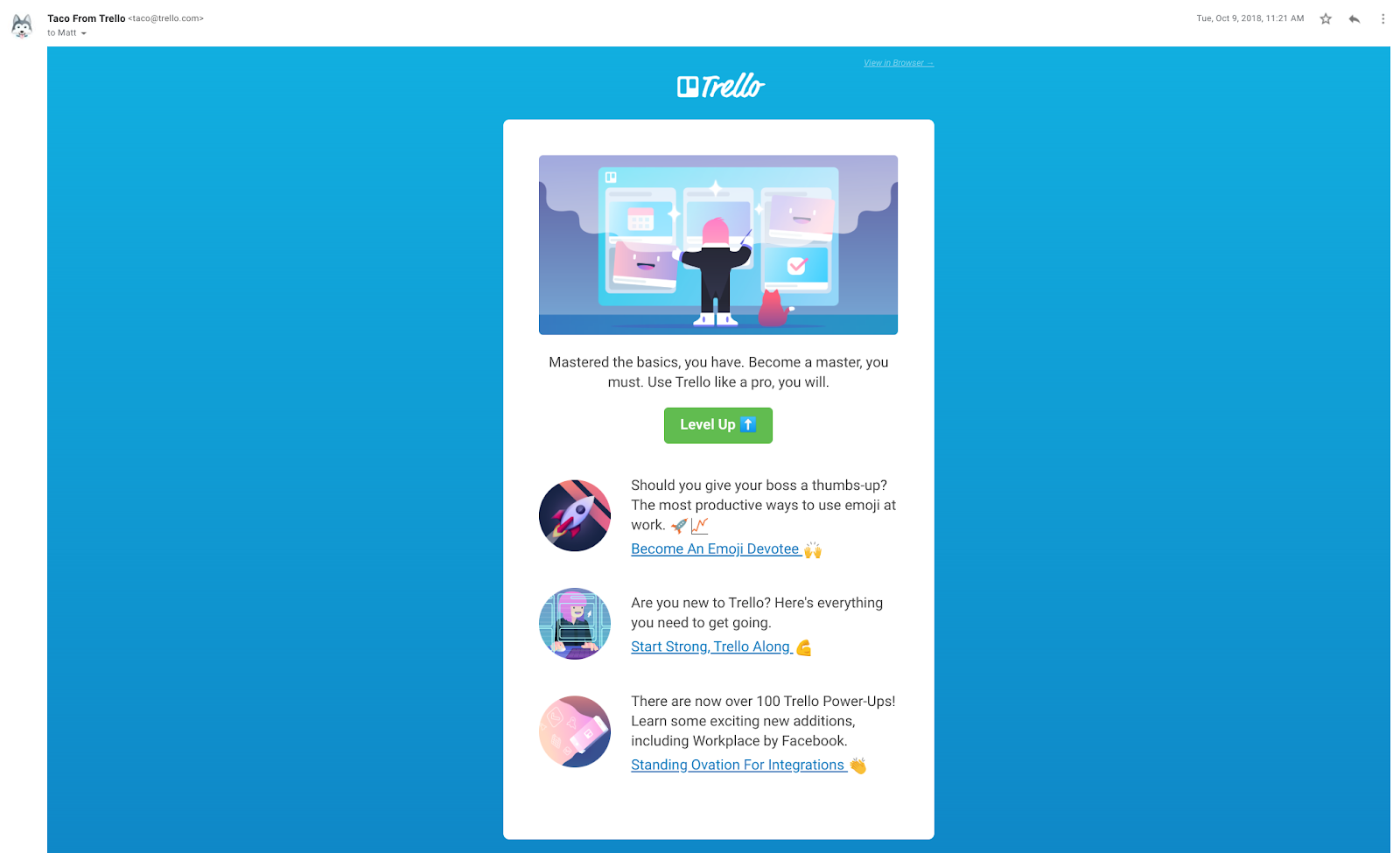
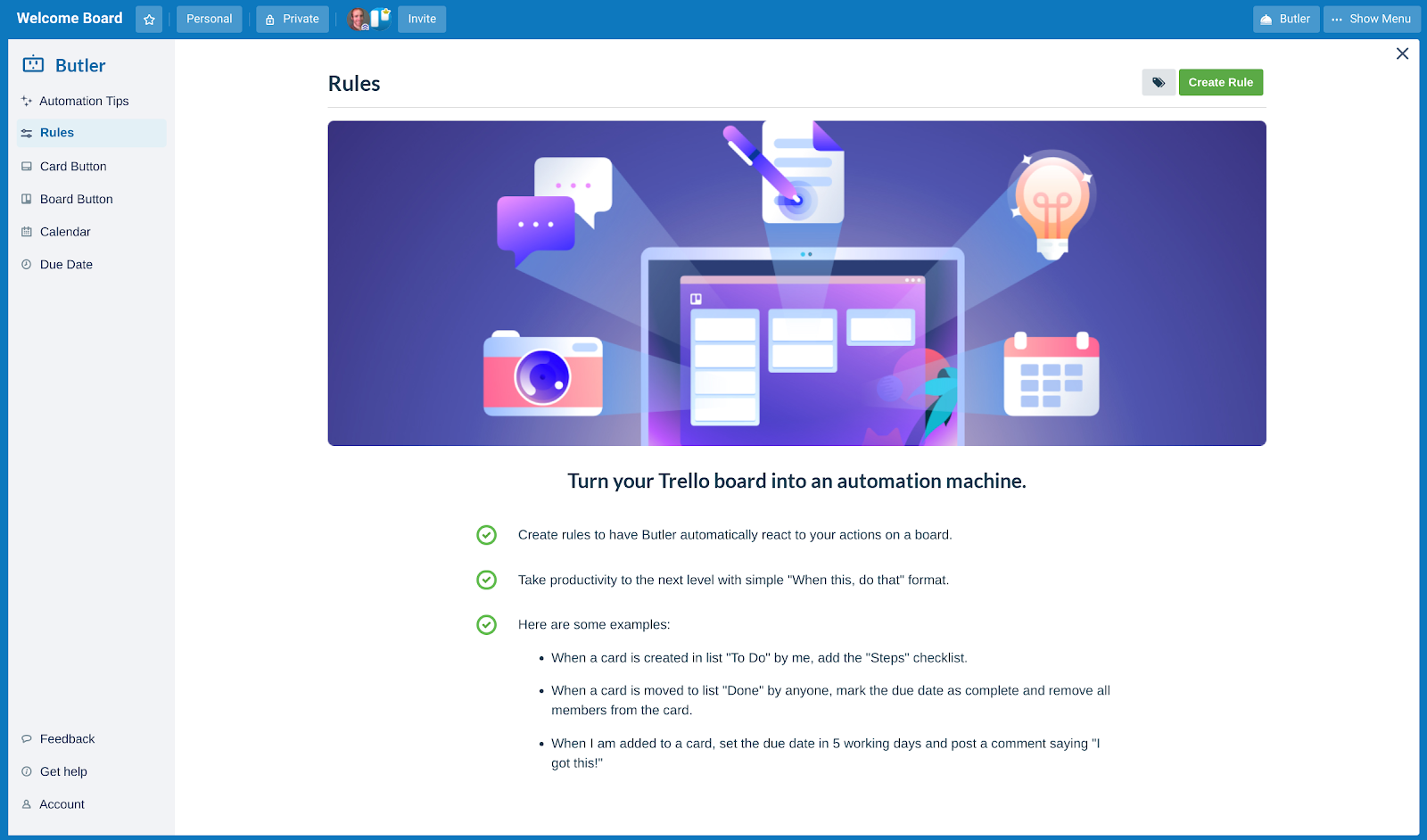
The idea is to gradually unroll the more advanced features your app has to offer as your users become more equipped to use them. (For example, most novice Trello users probably won’t be able to get much use out of automation features just yet.)
But, by introducing these features at just the right time in user’s lifecycle, you’ll deliver the exact value they need to continue using your app.
All good products evolve, and you’ll want to continue adding new features and functions to your app over time—and introducing them to your users as appropriate.
Here’s how GoToWebinar introduced its new Transcript feature in-app using Appcues:

In using email to follow up, here, GoToWebinar has a number of options, such as:
By providing in-depth instruction to your users across channels, you improve their ability to actually use the new features being unrolled, allowing them to get even more value from your app, overall. And by soliciting feedback from them, you ensure they stay engaged to see how else your app can help them in the future.
(And you can then use this feedback to make further improvements to the customer experience—both on an individual and audience-wide basis.)
Whether you’re aiming to convert freemium users for the first time or get your premium users to make additional purchases, aligning your in-app and email messaging is essential.
In certain cases, you’ll want to begin directly within the app. For example, Spotify informs freemium users when they’ve skipped too many tracks with a tongue-in-cheek nudge toward a Premium subscription:

From there, Spotfiy follows up via email with its famous “99 cents for 3 months” offer:

(And follows up… and follows up…)
Similarly, freemium users of Grammarly’s services are presented with a preview of all the additional editing features they’ll get once they become paying customers:

Users who view this page can then be sent a follow-up email further explaining the benefits of a Premium subscription:

The process of facilitating additional purchases from your users is similar to much of what we’ve discussed already. As always, you should be sure to focus on a user’s specific needs above all else—don’t make the mistake of sending all your users the same upgrade prompt indiscriminately or trying to upsell at the wrong moment.
A few ways you can upsell more thoughtfully:
And, of course, you’ll want to reach out via email to follow up with your individual users accordingly. Whether you offer additional information, a discount, or something else entirely should depend on what will provide the recipient with the best possible value.
Keeping your in-app and email messaging aligned and closely knit allows you to reinforce and enhance your communications with your audience.
More importantly, creating this alignment allows you to become more present in your users’ lives, and enables them to further integrate your brand into their daily routine, as well. The stronger this connection becomes, the more likely the user will be to stick around well into the future.
Psst—Looking for a formula that will let you automatically send the right email drip for each in-app action? Check out the Growth Lab by Appcues for inventive ways to combine your product stack with integrations.